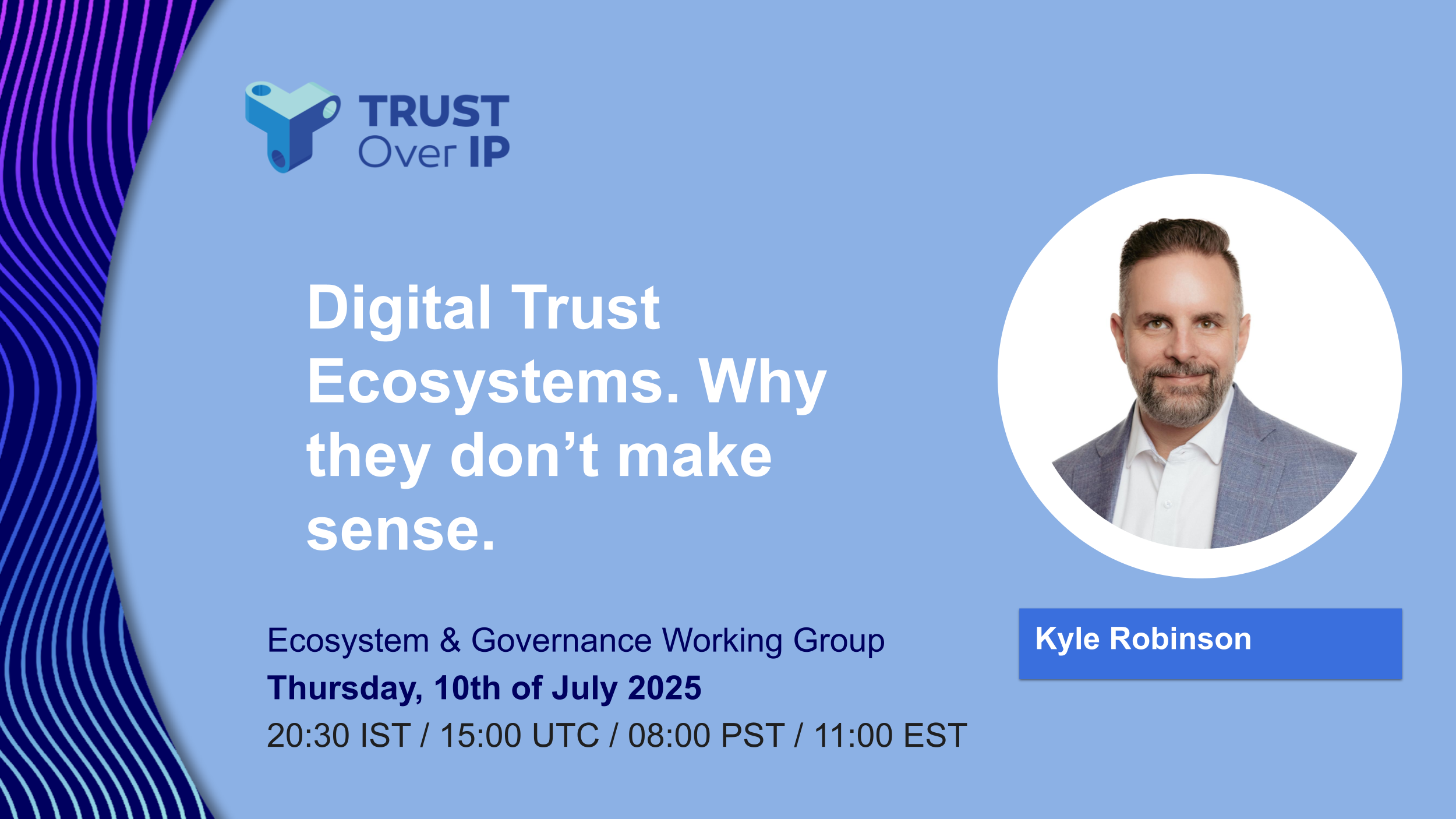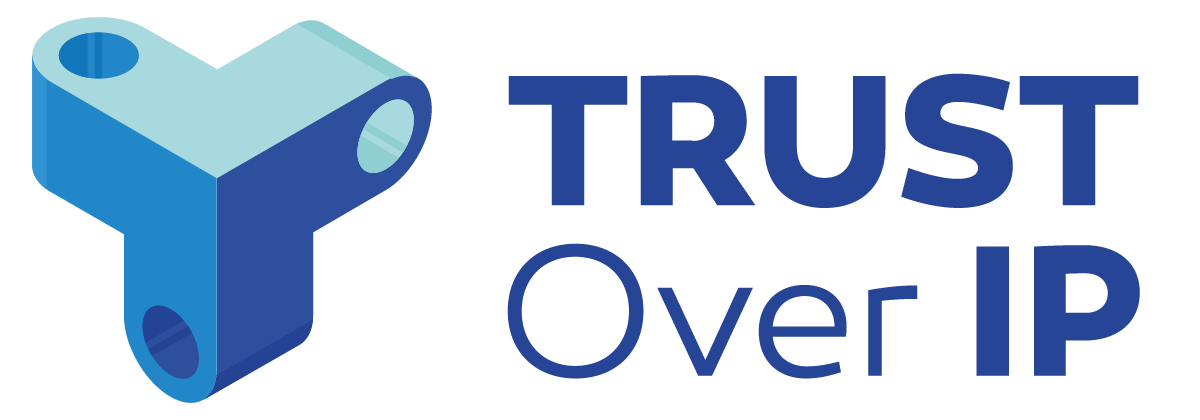
Status: Verified by Presenter
Please note that ToIP used Google NotebookLM to generate the following content, which the presenter has verified.
Google NotebookLM Podcast
Here is a detailed briefing document reviewing the main themes and most important ideas or facts from the provided source, generated by Google’s NotebookLM:
Excerpt
Learn why Kyle’s practical experience with the Canadian Province of British Columbia’s digital trust initiative has led him to focus on specific, high-impact digital credentials over broad “ecosystems.” Documenting these well fosters trust and enables organic growth and unpredictable efficiencies, naturally building interoperable digital trust networks.
Briefing Document: A Smarter Approach to Digital Credentials and Ecosystems
Date: July 10, 2025
Sources:
- “Digital Credentials Presentation” (Presentation Excerpts)
- “GMT20250710-145520_Recording.cc.vtt.txt” (Meeting Transcript – VTT)
- “GMT20250710-145520_Recording.m4a” (Meeting Audio – M4A)
- “GMT20250710-145520_Recording.transcript.vtt.txt” (Meeting Transcript – VTT)
- “GMT20250710-145520_RecordingnewChat.txt” (Meeting Chat Log)
Executive Summary
The prevailing approach of focusing on broad “ecosystems” for digital credential development is inefficient and limits opportunities. Instead, a more effective strategy involves starting with specific, high-impact credentials, rigorously documenting them in a trusted and public manner, and then allowing organic growth and adoption to naturally form interoperable networks. The Province of British Columbia (BC) is a leading example of this approach, leveraging foundational identity credentials and promoting their open use, which has led to unpredicted and valuable use cases and significant administrative efficiencies. The discussions highlight the “fractal” nature of ecosystems and the critical role of strong governance and transparency in building trust in digital credentials.
Key Themes and Most Important Ideas/Facts
1. The Flaws of an Ecosystem-First Approach
- Too Many Credentials to Tackle: Attempting to develop digital credentials for an entire industry or “ecosystem” simultaneously (e.g., healthcare or finance) is “a massive undertaking, resource-intensive, hard to coordinate, and risks spreading us too thin, leading to weak, untrusted credentials.” (Digital Credentials Presentation). As Kyle Robinson notes, “there’s just too many different types of credentials and different authorities for those credentials to really get a good handle on.” (Meeting Transcript).
- Constrains Opportunities: Pre-planning an entire ecosystem creates a rigid scope, preventing the discovery of “unexpected opportunities that could arise organically.” (Digital Credentials Presentation). Eric Drury echoes this, stating that “building a use case for an ecosystem is much more complicated than building a use case for a single credential.” (Meeting Transcript).
2. Recommendation: Start with Specific, High-Impact Credentials
- Build Trust and Quality: The core recommendation is to “focus on a few high-impact credentials, like a digital CPA certification. By putting all our effort into making them robust and trustworthy, we create a gold standard that people rely on. Trust drives adoption.” (Digital Credentials Presentation).
- Foundational Credentials as Catalysts: BC’s strategy focuses on “foundational credentials,” such as “identity of a person, identity of a business.” These are “foundational credentials which… kind of start right at the core of everything and then other credentials are built on top of those.” (Meeting Transcript). This layering allows for credentials like a “licensed doctor” to build upon a verified personal identity.
- Open More Doors Through Ripple Effects: Strong, well-executed credentials “create ripple effects.” (Digital Credentials Presentation). BC has observed this with their “lawyer credential,” where “all these what we call verifiers, or relying parties, started popping up, saying, oh, we could use that too, we could use that too, we could use that too.” (Meeting Transcript). This organic growth leads to “unpredicted” opportunities.
3. Credential Documentation: The Foundation of Trust
- Trusted Location: “Documentation must reside in a secure, reputable platform to ensure credibility.” (Digital Credentials Presentation). The BC Gov’s Digital Trust Toolkit is highlighted as a model for “transparent, trusted documentation that stakeholders can rely on.” (Digital Credentials Presentation). This toolkit serves as a “source of truth of governance documentation for credentials that are in production.” (Meeting Transcript).
- Active Promotion and Public Visibility: Documentation is insufficient without visibility. It “needs to be public, publicly exposed. So that a verifier can look at that document and have enough information to read it to be able to trust it.” (Meeting Transcript). This active promotion through various channels (webinars, industry forums, social media) “builds awareness and encourage adoption among users and organizations.” (Digital Credentials Presentation).
- Transparency of Issuance and Revocation: Trust extends beyond the technical aspects of a credential; it requires confidence in the “issuance process that the issuing authority goes through to be able to issue that to the right person, with the right attribute information.” (Meeting Transcript). Furthermore, visibility into “revocation status” is critical. If a ledger were to disappear, the ability to check revocation status would be lost, underscoring the need for robust infrastructure.
4. The Nature of Ecosystems and Organic Growth
- Fractal Nature of Ecosystems: The discussion introduces the concept of ecosystems as “fractal.” As Carly Huitema explains, “You can zoom in all the way into grains of dirt, and there’s an ecosystem there. And then you can zoom all the way out to the planet scale ecosystem.” (Meeting Transcript). This implies that “person is a microcosm” that can be “observed in other ecosystems,” with “boundaries are always fuzzy.” (Meeting Transcript).
- Market-Driven Adoption: The “overall drive of all of this is driven by those relying parties and verifiers.” When they “see value in doing something with credentials they will implement it, and they will tell their friends. And that’s sort of how you can see that growth and that adoption happening.” (Meeting Transcript). This organic growth is preferred over top-down, pre-defined ecosystem planning.
- Savings and Efficiency as Drivers: Digital credentials offer tangible benefits, such as “a ton of administrative time” savings for verifiers. For example, the City of Vancouver is realizing benefits where “nothing needs to be reviewed because the technology’s already trusting the stuff that the province is producing. So they don’t have to, like, have somebody manually reveal a form.” (Meeting Transcript).
5. Trust Beyond BC: Scaling and Interoperability Challenges
- Establishing “Legitimacy”: A key challenge is distinguishing “legitimate” from “non-legitimate” credentials beyond the issuing authority. BC addresses this by publishing the issuer DID, schema ID, and credential definition ID on the Candy ledger. This allows relying parties to cryptographically verify the origin.
- Cross-Jurisdictional Interoperability: The question of how this scales beyond BC is raised, particularly when different jurisdictions (e.g., Alberta, Rhode Island, Utah) might make different technical choices for their credentials. This mirrors the non-digital world where regulations define accepted IDs.
- Role of Trust Registries and Standards Bodies: The idea of “trust registries” is introduced as a potential solution for looking up legitimate issuers and their governance frameworks across jurisdictions. This could be driven by “standards bodies,” which could publish “trust registries published on their websites, or in some type of technology to say, hey, this standards body here, these are all of the organizations that we have audited and are following.” (Meeting Transcript).
- Government’s Evolving Role: While government’s primary role remains issuing foundational IDs and enforcing laws, its new role in “building and supplying software to citizens” (e.g., the BC Wallet app) is seen as a way to “help adoption.” (Meeting Transcript). The future may see OS manufacturers playing a larger role in built-in wallets.
Conclusion
The discussion reinforces that while the concept of a broad “ecosystem” might be a useful descriptive tool, the practical and successful implementation of digital credentials should pivot towards a credential-first approach. By focusing on building trust and quality in individual, high-impact credentials, making their governance transparent and public, and fostering organic adoption through demonstrated value, digital trust networks can emerge and grow naturally, leading to widespread benefits. The BC government’s experience serves as a compelling case study for this evolving strategy.
For more details, including the slides, meeting recording and transcript, please see our wiki 2025-07-10 Kyle Robinson & Digital Trust Ecosystems. Why they don’t make sense.
